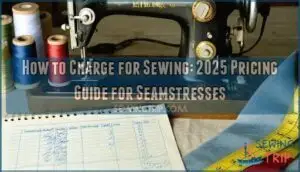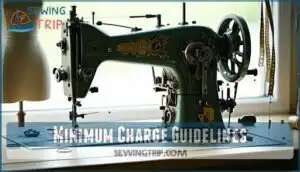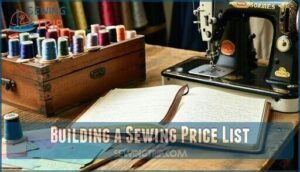This site is supported by our readers. We may earn a commission, at no cost to you, if you purchase through links.

Research what local seamstresses charge, but avoid undervaluing your skills. For alterations, consider project-based pricing to build client trust. Factor in complexity—hemming pants requires different pricing than custom wedding dresses.
Your rates should reflect both your growing expertise and the true cost of quality craftsmanship. The secret lies in finding that sweet spot between competitive pricing and profitable margins.
Table Of Contents
Key Takeaways
- Calculate your true costs first – You need to track materials, labor time at $16-24/hour, and overhead expenses like machine maintenance to avoid losing money on projects.
- Don’t undervalue your expertise – Your skills justify premium rates, so charge 10-20% less as a beginner but increase prices as you gain experience and reputation.
- Choose between hourly and project pricing strategically – Hourly rates work for complex jobs while project pricing builds client trust, but you’ll need minimums of $15-25 to stay profitable.
- Research competitors but stand firm on fair rates – Compare local and online pricing to stay competitive, but don’t compromise on rates that cover your actual costs plus reasonable profit margins.
Key Factors in Sewing Pricing
When you’re setting prices for your sewing services, you need to calculate three main areas: material costs, labor time, and business overhead expenses.
Understanding these pricing factors helps you charge fairly while ensuring your work remains profitable and sustainable.
Material and Supply Costs
Smart fabric sourcing starts with understanding your materials cost foundation. Pattern expenses can quickly add up, especially when pricing handmade items.
- Fabric sourcing – Quality cotton ranges $3-15 per yard
- Thread quality – Professional thread costs $2-5 per spool
- Trim selection – Ribbons and lace vary $1-10 per yard
- Hardware variety – Zippers and buttons range $0.50-5 each
- Pattern expenses – Commercial patterns cost $8-25 per design
Your selling price must cover every materials cost element.
Time and Labor Calculation
When tracking time for Project Complexity and skill level pricing, start with sewing time tracking to establish your baseline hourly rate. Track actual minutes from setup to completion, not just active sewing. Your hourly wage should exceed minimum hourly wages—aim for a living wage that values your expertise.
Time is money—track every minute from setup to final stitch to price your expertise fairly
| Task Type | Experience Level | Hourly Rate Range |
|---|---|---|
| Basic alterations | Beginner | $15-18 |
| Pattern work | Intermediate | $20-25 |
| Complex garments | Experienced | $30-40 |
| Specialty projects | Expert | $45-60 |
| Rush orders | All levels | +50% premium |
Overhead and Hidden Expenses
Beyond labor time, you’ll face overhead costs that eat into profits if you don’t account for them. Machine depreciation happens with every stitch, while needle costs add up quickly. Your studio space, whether rented or home-based, requires factoring into pricing. Don’t forget software subscriptions and insurance premiums when you set prices for sewing services.
- Machine depreciation and maintenance expenses
- Studio space costs (rent, utilities, storage)
- Insurance premiums and business licenses
- Software subscriptions and office supplies
Calculate these hidden expenses when determining your charge for services – they’re part of your true cost structure for calculating selling price.
How Much Should You Charge for Sewing?
You’ll need to determine your pricing based on several key methods that work best for your sewing business. Consider whether you’ll charge hourly rates, set per-project fees, or use a combination approach that accounts for material costs, time investment, and the complexity of each task.
Hourly Rates Vs. Per Project Pricing
When choosing between hourly rates and per project pricing for sewing services, consider how each affects your income predictability and client preferences. Hourly rates offer rate flexibility for complex projects but may concern clients about value perception.
Project scope pricing builds client trust through set prices, though you’ll need to carefully work out your selling prices to maintain profitability. Beginners should consider their lower hourly rates as they gain expertise.
Minimum Charge Guidelines
Setting service minimums protects your business from unprofitable jobs. Your minimum charge should cover basic overhead, even for quick tasks that take under an hour.
- Base minimum of $15-25 guarantees you meet minimum wage standards
- Factor in material surcharge for specialty fabrics or notions
- Add rush fees when clients need same-day turnaround
To safeguard safety and compliance, review consumer contract regulations. Work out your selling prices using this rule: never price below your hourly rate divided by expected output.
Adjusting for Complexity and Skill
Complex projects demand higher prices than basic alterations. Project difficulty justifies intricacy premiums – a simple hem costs less than couture finishing.
Your skill level pricing should reflect expertise in sophisticated techniques like French seams or bound buttonholes. Experienced sewers can bump their hourly rate for specialized work, making a profit on selling handmade goods that showcase true craftsmanship.
Consider factors affecting sewing skill costs when pricing.
Comparing Local and Online Sewing Rates
You’ll need to research what other sewists charge in your area and online to set competitive prices. Understanding these rate differences helps you position your services effectively, whether you’re targeting local customers or selling through digital platforms.
Researching Competitor Prices
Start by identifying direct competitors who offer similar sewing services in your area and online platforms like Etsy. Effective competitor analysis involves systematic price benchmarking across multiple channels.
Track hourly rates—document competitors charging $21.78 to $40.91 per hour for commercial work. Compare project-based pricing—note alterations, custom garments, and specialty items. Monitor online platforms—research Etsy fees, selling prices, and value perception strategies.
Evaluate service packages—assess bundled offerings and volume discounts. Update quarterly—market positioning shifts require regular price comparisons for accurate service comparison.
Identifying a niche is important to stand out, especially given the competitive market landscape.
Regional and Urban Price Differences
While the cost of living varies dramatically across regions, urban areas usually support higher pricing than rural markets. Market demand and economic factors create pricing power in cities that rural areas can’t match.
| Location Type | Average Hourly Rate |
|---|---|
| Major Cities | $25-40 |
| Suburban Areas | $18-25 |
| Small Towns | $15-20 |
| Rural Areas | $12-18 |
| Craft Fairs | Variable pricing |
Understanding sewing hourly rates is essential for pricing competitively. Adjust your selling price to match local economic conditions and charge for services accordingly.
Pricing for Online Sales Vs. In-Person
Online selling and selling at craft fairs each have unique cost structures. When selling on Etsy, you’ll face online marketplace fees and payment processing fees that eat into profits. Shipping costs add another layer to your pricing strategy. A key factor is understanding Etsy’s various fees.
- Materials cost stays constant, but customer acquisition cost varies greatly
- Selling fees online include Etsy’s 6.5% transaction fee plus listing fees
- In-person overhead means booth rental, travel, and display costs
- Price to sell must account for different fee structures in each channel
Building a Sewing Price List
You’ll need a detailed price list that covers common alterations, custom garments, and specialty projects to run a successful sewing business. Creating this list helps you quote jobs quickly and ensures you don’t undercharge for your skilled work.
Common Alterations and Repairs
Setting standard pricing for basic alterations and repairs helps you fix things efficiently while maintaining consistent income. Start with these common requests that clients need regularly. You’ll hem pants, handle zipper replacement, and alter clothes daily.
| Service | Price Range | Time Needed |
|---|---|---|
| Hem Adjustments | $10-18 | 15-30 min |
| Zipper Replacements | $15-35 | 45-90 min |
| Seam Repairs | $8-15 | 20-45 min |
| Button Replacements | $5-10 | 10-20 min |
| Patch Application | $12-25 | 30-60 min |
These rates reflect standard alterations across different regions and skill levels.
Custom Garment Pricing
Looking for guidance on custom garment pricing, you’ll need to balance client expectations with your skills and materials cost.
Factor in these essential components when determining your rates:
- Custom design fees for pattern creation and consultation time
- Patternmaking costs including drafting and testing phases
- Fabric sourcing expenses plus your time researching materials
- Fitting adjustments requiring multiple appointments and alterations
Calculate your base hourly rate, then add material expenses and selling fees to determine what to charge for custom work.
Specialty Projects (Curtains, Pillows, Etc.)
Specialty projects like Custom Home Decor require different pricing approaches. Your cost of materials plus hourly rate method still applies, but consider Unique Fabric Sourcing and Intricate Designs.
For Bulk Orders, offer volume discounts while factoring selling fees. Match Client Preferences to justify premium pricing.
Strategies for Communicating Pricing to Clients
You’ll find that clear pricing communication prevents misunderstandings and builds trust with your clients from the start.
When you explain your rates upfront and break down costs transparently, clients appreciate the honesty and you’ll avoid awkward conversations later.
Setting Client Expectations
Before discussing your fee structure, clients need realistic timelines and budget transparency. Don’t let them think alterations happen overnight or cost pocket change. Set clear service boundaries upfront about what you’ll tackle and what’s beyond your scope. Establish revision policies and communication frequency to avoid endless back-and-forth that eats your profit margins.
- A bride expecting her wedding dress alterations completed in two days when you need two weeks
- Clients shocked when your custom jacket price exceeds department store prices due to quality materials
- Someone requesting unlimited revisions without understanding each change requires additional payment
- Customers calling daily for updates when you’ve established weekly check-ins as your standard communication frequency
Explaining Costs Clearly
When pricing transparency becomes your secret weapon, clients understand why you charge what you charge. Break down each fee clearly: materials cost plus labor time equals your total price. Detailed invoices prevent misunderstandings by showing fabric expenses, thread, and hourly rates.
Justifying value means explaining how your skills save them money long-term. Clear payment policies protect both parties. Many seamstresses struggle with pricing because of underestimating handmade value.
Handling Price Negotiations
When clients push back on your prices, stay calm and stick to your guns. You can’t charge someone something for nothing – the cost of materials alone justifies your baseline rate.
Use negotiation tactics like offering scope adjustments rather than price cuts. If their budget limits are tight, consider modified payment terms or simplified designs.
Always explain your value justification clearly.
Maximizing Profit in Your Sewing Business
You can turn your sewing skills into a profitable business by focusing on three key areas: utilizing your experience to command higher rates, adding healthy profit margins to cover all expenses, and streamlining your workflow to reduce costs.
These strategies help you move beyond just covering expenses to actually building wealth from your craft.
Value of Experience and Skill
Your experience isn’t just about time served—it’s your ticket to charge more. Years of handling complex alterations and mastering tricky fabrics justify skill premium rates. Don’t undervalue expertise that took time to develop.
Each learning curve you’ve conquered translates to efficiency gains that reduce materials cost waste. When clients see your reputation value, they’ll understand why your paid job commands higher fees than beginners charge for similar work.
Adding Profit Margins
Smart business owners don’t work for free. After covering your cost of materials and labor, add a healthy margin percentage to secure profits.
Many successful Etsy shop owners charge for premium services using value-based pricing—customers pay more for expertise and quality. Start with 20-30% margins on basic work, then scale margins higher for specialty projects.
Consider the startup equipment investment needed to provide high-quality service. Competitive margins keep you profitable while attracting clients who value craftsmanship.
Reducing Costs and Increasing Efficiency
Cut costs without sacrificing quality through smart material sourcing strategies. Buy supplies in bulk to reduce materials cost per project.
Implement batch sewing techniques to accelerate production and optimize machine time. Regular machine maintenance prevents costly repairs, while workspace optimization boosts productivity.
Focus on skill development to charge for higher-value services and reduce time spent on basic tasks.
Frequently Asked Questions (FAQs)
How do I calculate the cost of my materials?
Track every expense: fabric, notions, thread, interfacing, and hardware. Add up material costs, then multiply by 2-3x for retail pricing or add your hourly labor rate plus 10% overhead.
How much should I charge for my time?
Like time being money in Franklin’s wisdom, you should charge $16-24 per hour for basic sewing work. Factor in your skill level, location, and project complexity when setting rates.
What factors should I consider when pricing my products?
Consider material costs, labor time, skill level required, local market rates, overhead expenses, and profit margins. Factor in complexity, customization needs, and your target audience’s budget expectations.
How do I compare my prices to those of other sellers?
Research local seamstresses online and visit fabric stores to ask about typical rates. Check Etsy, Facebook Marketplace, and local classified ads. You’ll discover regional pricing patterns that help position your services competitively within your market.
How can I make sure I’m pricing my products fairly?
Fair pricing starts with calculating your true costs: materials plus labor at $16-24 per hour. Basic alterations usually command $15-50 per hour, while complex work reaches higher rates.
You’ll need to balance competitive market research with your actual expenses to stay profitable.
Should I charge rush fees for urgent projects?
Yes, you should charge rush fees for urgent projects. They compensate for disrupted schedules, overtime work, and stress. Usually add 25-50% to your base rate for last-minute requests.
How do I price vintage or delicate fabric work?
You’ll need to charge premium rates for vintage work since delicate fabrics require specialized skills, gentler handling, and often custom techniques that take longer than standard projects.
What about pricing for wedding dress alterations specifically?
Planning that dream wedding but worried about alteration costs? Wedding dress alterations usually range from $700 to $1000 for standard adjustments.
You’ll charge premium rates here—complex beadwork and bustles justify higher fees than basic hemming.
Should beginners charge less than experienced seamstresses?
You can start with lower rates while building your reputation and skills. Charge 10-20% less than experienced professionals initially, then gradually increase prices as you gain confidence and client testimonials.
How do I handle pricing when clients supply materials?
Like threading a needle with precision, you’ll charge only for your labor when clients provide materials. Calculate your hourly rate, track actual sewing time, and add any additional supplies you contribute beyond their fabric.
Conclusion
Sarah started charging $15 per hour for alterations but realized she was losing money after calculating fabric costs and machine wear. Now she charges $45 hourly and books weeks ahead.
Mastering how to charge for sewing requires balancing fair compensation with competitive rates. You’ve learned to calculate material costs, track time accurately, and factor in overhead expenses. Remember that your skills deserve proper payment—don’t undervalue your craftsmanship. Start with research, set clear pricing structures, and communicate value to clients confidently. Your sewing business will thrive when you price strategically and stand firm on rates that reflect quality work.
- https://www.payscale.com/research/US/Skill=Sewing/Hourly_Rate
- https://sewboise.com/wp-content/uploads/2022/01/ALTERATIONS-PRICE-LIST-2022.pdf
- https://so-sew-easy.com/selling-what-you-sew-how-to-price-your-work/
- https://www.reddit.com/r/sewing/comments/osolu8/advice_on_pricing_custom_dressmaking_work/
- https://www.ziprecruiter.com/Salaries/Sewing-Salary-in-Alexandria,VA















